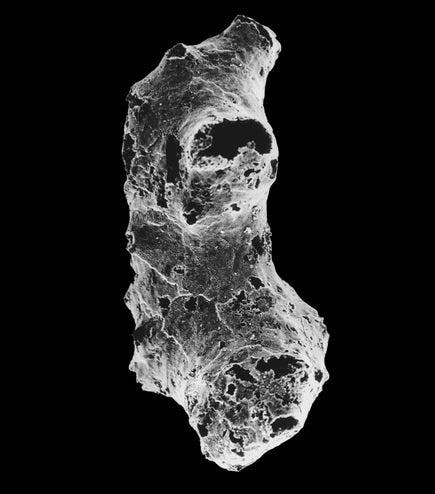 |
| The 710 million year old fossil of Otavia antiqua - possibly the oldest known sponge on the planet |
Archaeocyathans fill the Cambrian fossil record, but their Precambrian record is sparse. A discovery made in 2012 of a 710 million year old sponge-like fossil named Otavia antiqua suggests that they have a deep rooted evolutionary history, but its identity is nevertheless disputed. Now a new find from the Doushantuo Formation in China has pushed their undisputed record back to 600 million years ago.
Just over a millimetre across, the fossil looks like a grain of sand to the naked eye, but under a scanning electron microscope its details become more apparent. Three hollow, tubular structures connect at the base of the animal. Each tube appears to be covered in a layer of cell remains which resemble pinacocytes. Pinacocytes form the outer layer of sponges which has pores connecting the inner cavity of the body with the surrounding ocean. These pores are the defining feature of sponges as they allow water into the body cavity where nutrients and metabolic waste can be exchanged. The fossil displayed pores alongside possible pinacocytes, giving it a cellular link to modern sponges.
 |
| The 600 million year old sponge Eocyathispongia qiania |
So far the authors of the paper published on the fossil have stated: 'Discovery of additional specimens would confirm that the fossil represents a Precambrian sponge, but features of the fossil are consistent with sponge anatomy, including a basal anchor similar to a sponge hold-fast and orifices for water inflow and outflow.'
What is interesting is the degree of complexity displayed by the sponge, which has since been given the name of Eocyathispongia qiania, suggesting that it is not among the earliest members of the group. As it cannot be precisely placed among modern sponge groups, yet displays certain specialisations seen in modern groups, the authors classified Eocyathispongia as belonging to an extinct stem group. What this means is that sponges must have first evolved even earlier in geological history, thus strengthening the case of Otavia as an early sponge. At any rate, sponges have a firm presence in the Precambrian. Ecological surprises now lie in wait.